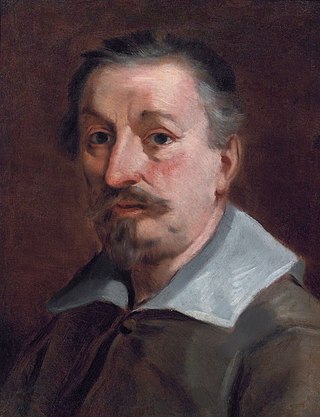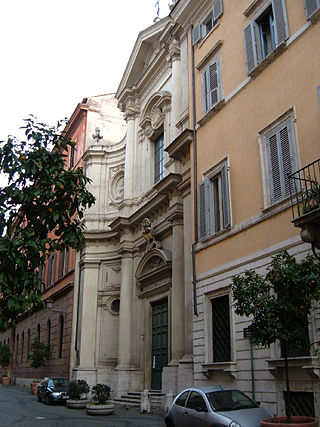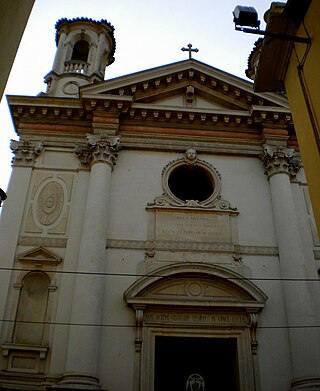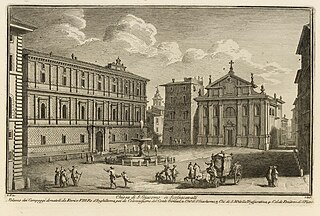The Oratorio del Gonfalone or Oratory of the Banner is a building in Central Rome which once housed a Catholic fraternity. Since about 1960 it has served as a concert venue for the Roman Polyphonic Choir.
Contents

The Oratorio del Gonfalone or Oratory of the Banner is a building in Central Rome which once housed a Catholic fraternity. Since about 1960 it has served as a concert venue for the Roman Polyphonic Choir.

The Confraternity of the Gonfalone was a group of white penitents (due to the colour of their robe). The association was first established in 1264 the church of Santa Maria in Aracoeli, under the name of the Accomandati di Madonna Santa Maria. It came to be called the Gonfalone Confraternity because of the banner carried in processions. [1]
Over the centuries the group dedicated itself to various activities, including the participation in religious processions as banner carriers (wearing white gowns with peaked blue hoods), and also of putting on a yearly passion play. They also were involved in charity towards the poor and needy, and during 1581–1765, of freeing Italians enslaved in Muslim and Slavic lands.
Pope Martin V assigned to the confraternity, the old Church of Santa Lucia Vecchia, which had served as a hospice for pilgrims. A fair called "La Sposa", was held in the area annually on the Feast of St. Lucy. In 1486, Pope Innocent VIII, united a number of confraternities under the name " Confraternita del Gonfalone". As the church was close to the Tiber and subject to flooding, he transferred the confraternity to Santa Lucia ai Banchi Vecchi.
The Oratorio was built between 1544 and 1547, by the Confraternity on the ruins of the Church of Santa Lucia Vecchia which can still be seen in the basement. In 1579 Pope Gregory XIII raised it to the rank of an archconfraternity.
In 1890, the Archconfraternity was dissolved and its property devolved to the state. In October 1960 the Oratory, restored by the Superintendency of the Galleries and the works of art of Rome, was entrusted to the Roman Polyphonic Choir. It now serves as a concert venue. [2]
The building on Via del Gonfalone 32a (near corner of Via Giulia and Vicolo della Scimmia) has a modest façade, designed by Domenico Castelli, resembling a simple church. [3]
Inside, a team of prominent Mannerist painters were recruited between 1569–1576 to complete elaborate wall fresco decoration of scenes of the passion. Artists included Giacomo Zanguidi (il Bertoia) (Entry of Christ to Jerusalem); Livio Agresti (Last Supper); Marco Pino (Crown of Thorns); Federico Zuccari (Flagellation of Christ); Raffaellino Motta da Reggio (Christ before Pontius Pilate [4] and Prophet and Sibyls); and Cesare Nebbia (Crown of Thorns and Ecce Homo). The main altarpiece is painted by Roviale Spagnolo. The site has been called the Sistine chapel of Mannerism. The Passion panels are flanked by quadratura spiral columns and surmounted by images of prophets and sybils. The Oratory bears the arms of Alessandro Farnese, Cardinal-protector. [5] Cardinal Odoardo Farnese was also involved with the Oratorio. [6]
Note there are at least two other Oratorio del Gonfalone in Italy, also highly decorated in the interior, one at Fabriano and the other at Vicenza.

Francesco Albani or Albano was an Italian Baroque painter who was active in Bologna (1591–1600), Rome (1600–1609), Bologna (1609), Viterbo (1609–1610), Bologna (1610), Rome (1610–1617), Bologna (1618–1660), Mantova (1621–1622), Roma (1623–1625) and Florence (1633).

Sebastiano Ricci was an Italian painter of the late Baroque school of Venice. About the same age as Piazzetta, and an elder contemporary of Tiepolo, he represents a late version of the vigorous and luminous Cortonesque style of grand manner fresco painting.

The gonfalon, gonfanon, gonfalone is a type of heraldic flag or banner, often pointed, swallow-tailed, or with several streamers, and suspended from a crossbar in an identical manner to the ancient Roman vexillum. It was first adopted by Italian medieval communes, and later, by local guilds, corporations and districts. The difference between a gonfalon with long tails and a standard is that a gonfalon displays the device on the non-tailed area, and the standard displays badges down the whole length of the flag.

The Via Giulia is a street of historical and architectural importance in Rome, Italy, which runs along the left (east) bank of the Tiber from Piazza San Vincenzo Pallotti, near Ponte Sisto, to Piazza dell'Oro. It is about 1 kilometre long and connects the Regola and Ponte Rioni.

The Church of the Most Holy Name of Mary at the Trajan Forum is a Roman Catholic church in Rome, Italy. This church should not be confused with the church Santissimo Nome di Maria in Via Latina in south-east Rome.

Cristoforo Roncalli was an Italian mannerist painter. He was one of the three painters known as Pomarancio or Il Pomarancio.

The Oratorio del Santissimo Crocifisso or the Oratory of the Most Holy Crucifix is a building in central Rome, Italy. Located next to the church of San Marcello al Corso, it served as a prayer hall and meeting house for the Archconfraternity of the Most Holy Crucifix. It is best known, like the Oratorio del Gonfalone, which shares the same artists, for its Mannerist decorations.

A confraternity is generally a Christian voluntary association of laypeople created for the purpose of promoting special works of Christian charity or piety, and approved by the Church hierarchy. They are most common among Roman Catholics, Anglicans, Lutherans and the Western Orthodox. When a Catholic confraternity has received the authority to aggregate to itself groups erected in other localities, it is called an archconfraternity. Examples include the various confraternities of penitents and the confraternities of the cord, as well as the Confraternity of the Rosary.
San Bernardo della Compagnia was a small church in Rome, next to Trajan's Column, dedicated to Saint Bernard and the Virgin Mary.
The Archconfraternity of the Most Precious Blood was founded by Francesco Albertini, canon of the Basilica di San Nicola in Carcere, Rome, in 1808.

Confraternities of penitents are Christian religious congregations, with statutes prescribing various penitential works; they are especially popular in the Catholic Church. Members of the confraternities of penitents practice mortification of the flesh through fasting, the use of the discipline, the wearing of a hair shirt, among other instruments of penance, etc.

The Church of Saint Lucy in Selci is an ancient Roman Catholic church, located in Rome, dedicated to Saint Lucy, a 4th-century virgin and martyr.

Santa Lucia del Gonfalone is a church in the diocese of Rome, Italy. It is located on Via dei Banchi Vecchi just one block south of Corso Vittorio Emanuele. The former site of the Archconfraternity of the Gonfalone, the Claretian Missionaries have their provincial headquarters here. The church was made a cardinalate deaconry by Pope John Paul II on 21 October 2003.

The Oratory of San Francesco Saverio del Caravita is a 17th-century baroque oratory in Rome, near the Church of Sant’Ignazio in rione Pigna. It is home to the Caravita Community, an international English-language Catholic community in Rome.

San Giovanni Decollato is a Roman Catholic church in Rome, sited on via di San Giovanni Decollato in the Ripa rione, a narrow road named after the church. Its construction took most of the 16th century.

Santa Caterina da Siena is a church in Rome dedicated to Catherine of Siena. It is sited on via Giulia in the Regola district.

Santa Croce is a Roman Catholic church located on Corso Vittorio Emanuele 178 in Padua, Veneto region, Italy.

San Giacomo Scossacavalli was a church in Rome important for historical and artistic reasons. The church, facing the Piazza Scossacavalli, was built during the early Middle Ages and since the early 16th century hosted a confraternity which commissioned Renaissance architect Antonio da Sangallo the Younger to build a new shrine. This was richly decorated with frescoes, painted by mannerist artist Giovanni Battista Ricci and his students. The church was demolished in 1937, when Via della Conciliazione was built and the piazza and central part of the Borgo rione were demolished. Many decorative elements still exist, since they were preserved from demolition.

San Michele Arcangelo ai Corridori di Borgo was a church in Rome dedicated to St. Michael, the Archangel, important for historical and artistic reasons.

The crucifix of San Marcello is a medieval work of religious art that is venerated in the Oratory of Santissimo Crocifisso of the Church of San Marcello al Corso in Rome. Having survived a fire that destroyed the church in 1519, the crucifix was popularly believed to possess intercessory powers. During an epidemic of plague in 1522 the crucifix was carried in a procession through the city. According to popular belief at the time, the procession caused the plague to leave the neighborhoods through which the crucifix passed, and eventually to die out in Rome.
Coordinates: 41°53′50.6″N12°27′58.82″E / 41.897389°N 12.4663389°E